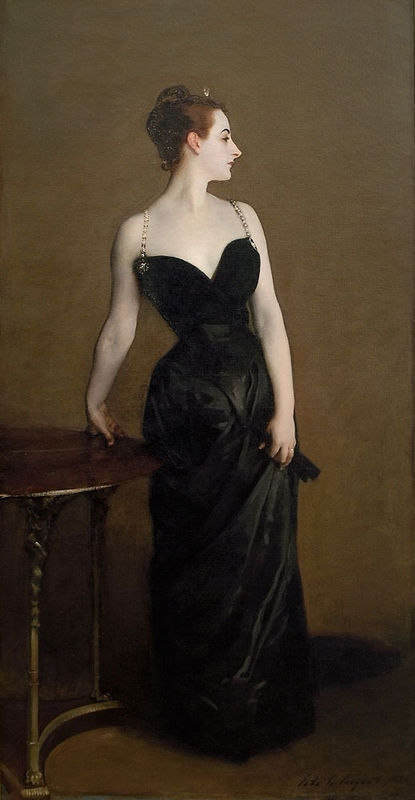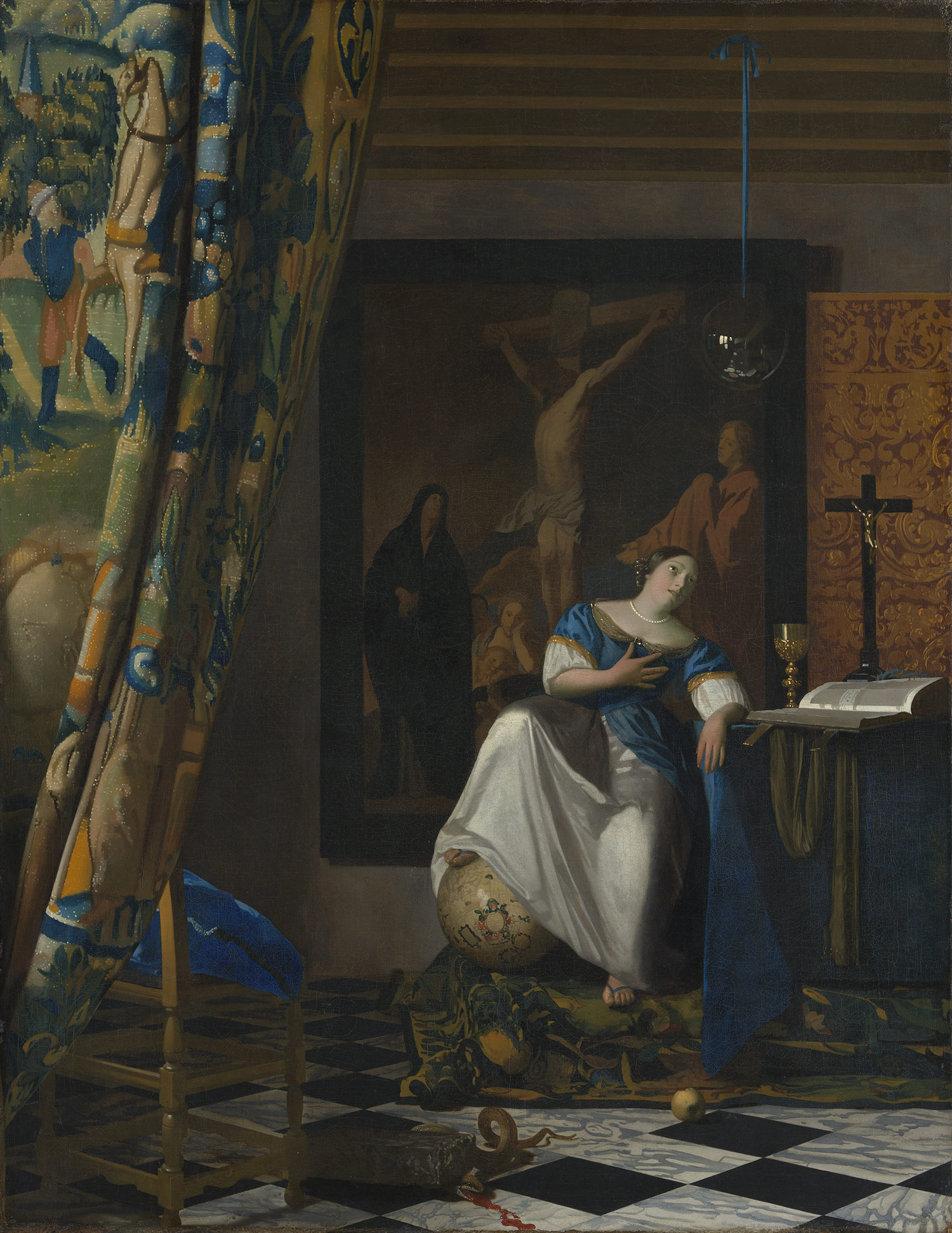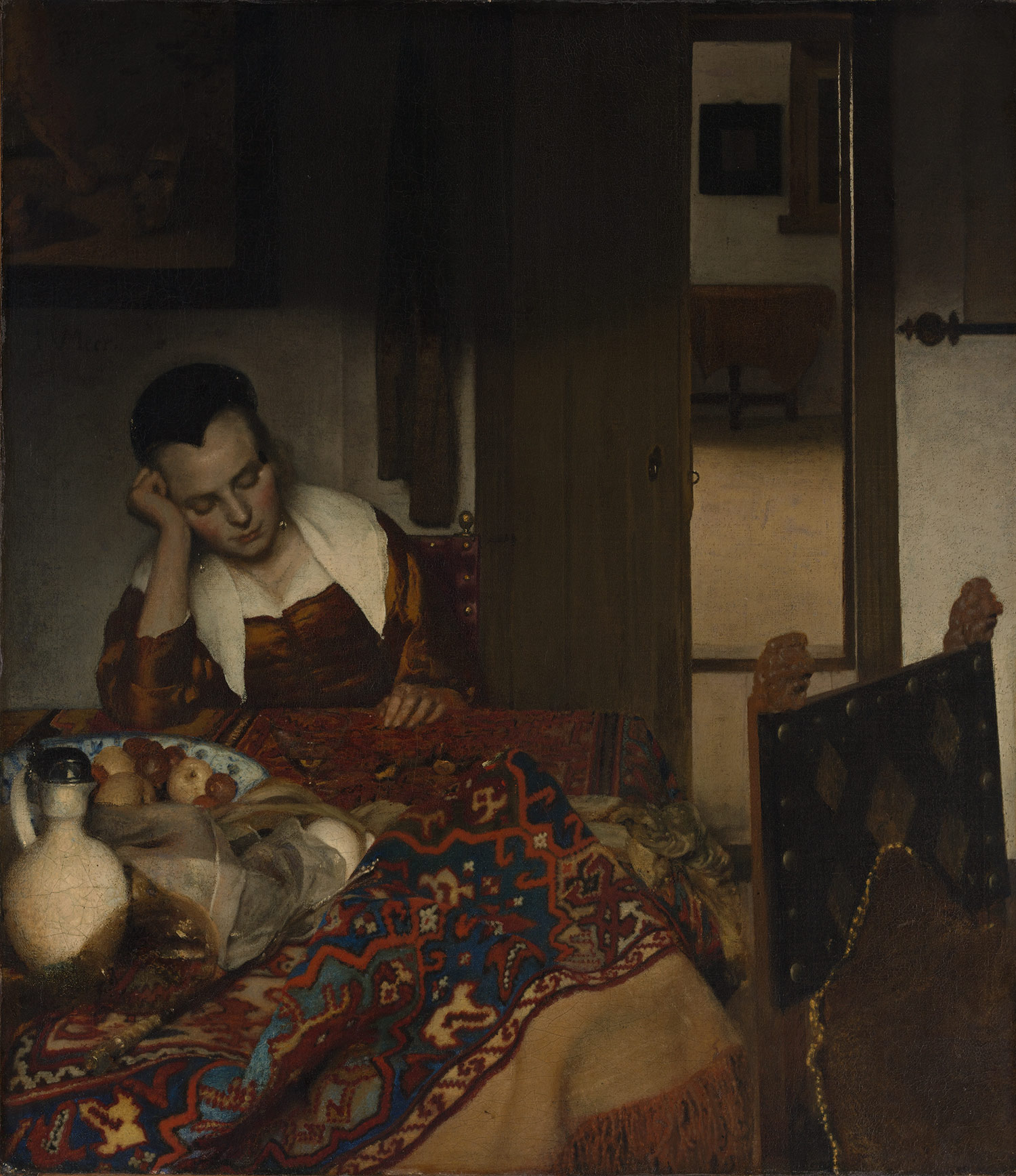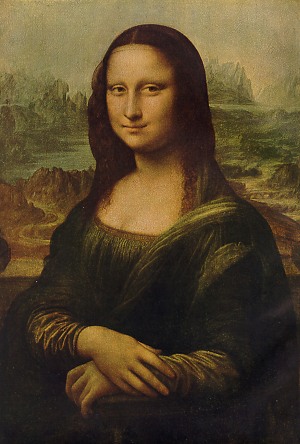Madame X
1884, John Singer Sargent

Character - Madame X (Madame Pierre Gautreau)
Historical Period - During the Era of portraits, ending with the Great War, which made Sargent a commissioned painted for the rich and for the war.
Background - Sargent had been mesmerized by Madame Gautreau's good looks and believed that a portrait of her would solidify his reputation as a famous painter at the Paris Salon. He did achieve this, but not in the manner he had anticipated. The reception at the Salon in 1884 was scathing, the distinctive profile of the Madame made her recognizable, although her name was revealed. Critics complained that her skin had lavender undertones and that the right arm was oddly contorted. Most of the outrage was at her dress. In the original version showed, her right strap had slipped off her bare shoulder.
Iconology - The slipped strap and the plunging neckline hinted at the sexual impropriety or infidelity of the subject. Gautreau's family was mortified and begged Sargent to withdraw the painting. As soon as he was allowed to remove it from the Salon, he fixed the strap, resulting in the figure above.
Allegory of the Catholic Faith
Johannes Vermeer, 1670-1672

Character - The idealized figure is the Catholic Faith
Historical Period - This piece was done in a time when Iconology was well studied, and many people would know what certain things stood for. In today's day we do not understand the picture fully because we do not understand the references.
Background - Painted about 1670–72, this picture presents an allegory of Vermeer's adopted religion, and was probably made expressly for a private Catholic patron or for a schuilkerk, a hidden Catholic church. It is unlike any other work by Vermeer, though it shows compositional similarities to The Art of Painting (Kunsthistorisches Museum, Vienna) of about 1666–68. The latter work is also allegorical in subject, but only nominally, as it was intended mainly as a virtuosic display of the artist's abilities. In the MMA canvas, Vermeer shifts his late style towards a more classicist and schematic manner.
Iconology - The choice and interpretation of the imagery included here would have been discussed by the artist and his patron. For many of the allegorical motifs, Vermeer must have turned to Cesare Ripa's emblem book, Iconologia (Rome, 1603), translated in a Dutch edition by Dirck Pietersz Pers (Amsterdam, 1644). The female figure represents the Catholic Faith, wearing white, a symbol of purity, and blue, the "hue of heaven". A hand raised to the heart indicates the source of living faith. She rests her foot on a globe, published in 1618 by Jodocus Hondius, to illustrate Ripa's description of Faith with "the world under her feet". In the foreground, Vermeer shows the "cornerstone" of the Church (Christ) crushing a serpent (Satan). The nearby apple, which has been bitten, stands for original sin. The table is transformed into an altar with the addition of a chalice, crucifix, and a Bible or, more likely because of its proximity to other objects used for the Mass, a missal. The glass sphere, hanging from a ribbon, was a popular decorative curiosity; in this context, it may be viewed as a symbol of heaven or God. The room itself, with its high ceiling, marble floor, and a large altarpiece based on a work by Jacob Jordaens (possibly identical with one in Vermeer's estate), was meant to be recognized by contemporary viewers as a private chapel installed within a large house or some other secular building. Though apparently an illusionistic device, the tapestry at left would also have been understood as part of a very large hanging, drawn aside to reveal a normally secluded space.
A Maid Asleep
Johannes Vermeer, 1656-57

Character - A Maid
Historical Period - Same as above
Background - This picture is possibly Vermeer's first effort in the field to which he devoted nearly all of his mature career: scenes of domestic life, usually focusing on a woman's personal surroundings. It probably dates from 1656 or 1657, following Diana and Her Companions of about 1653–54 (Mauritshuis, The Hague), Christ in the House of Mary and Martha of about 1655 (National Gallery of Scotland, Edinburgh), and The Procuress, dated 1656 (Gemäldegalerie Alte Meister, Dresden). It is likely one of the earliest works by Vermeer to have been acquired by the contemporary Delft collector Pieter Claesz van Ruijven (1624–1674), who owned all or at least most of the twenty-one paintings by Vermeer sold in the estate sale of his son-in-law, Jacob Dissius, in 1696.
Iconology - This canvas of 1656 or 1657 is the earliest work by Vermeer to depict his usual subject of one or two figures in a domestic interior. The wine glass and unsettled objects on the table suggest that some social occasion has passed. To the upper left, the corner of a painting of Cupid (known from other pictures by Vermeer) includes a fallen mask which refers to the woman's unguarded expression. Radiographs reveal that Vermeer originally included a man in the background and a dog in the doorway; these motifs were replaced by the distant mirror and the chair with a pillow to the lower right. In changing the composition Vermeer made its amorous theme less obvious, just as his remarkable passages of observation obscure his borrowing of ideas from other genre painters, such as Nicolaes Maes.
Leonardo Da Vinci, 1452-1519
La Gioconda

Character - Mona Lisa or "la Gioconda" The Laughing one
Historical Period - The Renaissance
Background - Mona Lisa was not well known until the mid-19th century when artists of the emerging Symbolist movement began to appreciate it, and associated it with their ideas about feminine mystique. Critic, Walter Pater, in his 1867 essay on Leonardo, expressed this view by describing the figure in the painting as a kind of mythic embodiment of eternal femininity, who is "older than the rocks among which she sits" and who "has been dead many times and learned the secrets of the grave.
Iconology - There has been much speculation regarding the painting's model and landscape. For example, that Leonardo probably painted his model faithfully since her beauty is not seen as being among the best, "even when measured by late quattrocento (15th century) or even twenty-first century standards." Some art historians in Eastern art, such as Yukio Yashiro, also argue that the landscape in the background of the picture was influenced by Chinese Paintings, however, this thesis has been contested for lack of clear evidence.
Romulus' Victory over Acronn
Jean-Auguste-Dominique Ingres. 1812
Character - Shows Romulus After the Victory for Rome
Historical Period - Unknown
Iconology - Jean Ingres’ “Romulus, Conqueror of Acron” of 1812. Ingres was born in Montauban in 1780 and at the age of sixteen he went to Paris to study under David. He won the Grand Prix in 1801. He went to Rome in 1807 having secured a following in the art world. He continued to mature and gather a greater gathering until his death in 1867. Romulus, Conqueror of Acron, was created as a large painting for the salon of Napoleon I. It recalls the earliest and mythological history of Rome and reflects the Napoleonic obsession with all things Roman and Classical. The original painting is in the Ecole des Beaux-Arts in Paris.
Background - A few important commissions came to him; the French governor of Rome asked him to paint Virgil reading the Aeneid (1812) for his residence, and to paint two colossal works— Romulus' victory over Acron (1812) and The Dream of Ossian (1813)—for Monte Cavallo, a former Papal residence undergoing renovation to become Napoleon's Roman palace. These paintings epitomized, both in subject and scale, the type of painting with which Ingres was determined to make his reputation, but, as Philip Conisbee has pointed out, "for all the high ideals that had been drummed into Ingres at the academies in Toulouse, Paris, and Rome, such commissions were exceptions to the rule, for in reality there was little demand for history paintings in the grand manner, even in the city of Raphael and Michelangelo." Art collectors preferred "light-hearted mythologies, recognizable scenes of everyday life, landscapes, still lifes, or likenesses of men and women of their own class. This preference persisted throughout the nineteenth century, as academically oriented artists waited and hoped for the patronage of state or church to satisfy their more elevated ambitions."
No comments:
Post a Comment